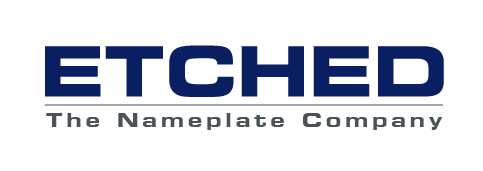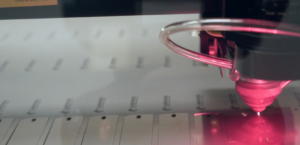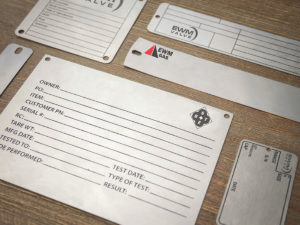
Etched or engraved compliance and safety plates are crucial markers of compliance to regulatory standards and safety protocols in a wide variety of industries. Safety plates can communicate essential information about how to effectively and safely operate dangerous or complex equipment; by customizing their plates with specific details such as serial numbers, safety warnings, calibration dates, and more, manufacturers can better protect their employees, contractors, and customers.
At Etched, we have decades of experience creating custom compliance and safety plates for industries around the world. In this buyer’s guide, we’ve assembled all the information you may need to know before ordering.
What are common applications of compliance and safety plates?
Compliance and safety plates are especially heavily used in the hearth and home industry, where they may serve as lighting instruction plates, log placement tags, and more. Specifically, you may need custom compliance and safety plates to facilitate the installation of:
- Fireplace inserts: Compliance plates can provide information about installation requirements, fuel type compatibility, and maintenance schedules, ensuring safe and efficient operation while minimizing the risk of fire hazards.
- Wood stoves: Safety plates communicate clearance distances from combustible materials, proper installation procedures, and emissions compliance.
- Gas appliances: Custom plates are especially important on gas fireplaces or gas logs to indicate adherence to regulatory standards for gas safety, including proper venting, gas line connections, and carbon monoxide emissions limits.
- Electrical panels: Safety plates can specify load capacities, voltage ratings, and proper wiring practices, reducing the risk of electrical fires or shocks in residential settings.
Why are compliance and safety plates important?
For complex or dangerous equipment, custom plates are essential to communicate operating and installation instructions. There are many regulations governing the warnings that must be communicated to installers and/or the end user of a product, so durable and legible compliance and safety plates can help manufacturers protect themselves from liability.
What regulations govern the use of compliance and safety plates?
Etched or engraved compliance and safety plates can help ensure compliance with ANSI safety guidelines and OSHA regulations. For the hearth and home industry specifically, custom plates can communicate a product’s CSA, ETL, and UL certifications.
Material options for compliance and safety plates
At Etched, we specialize in manufacturing compliance and safety plates using a diverse range of materials, each tailored to specific industry and environmental needs.
Stainless steel
Renowned for their resilience, stainless steel compliance plates excel in environments prone to corrosion and wear. Whether installed in coastal areas or exposed to frequent movement, stainless steel ensures durability and sustained readability. We offer stainless steel in thicknesses ranging from 0.018” to 0.125”, with options for both 316 and 304 grades. Additionally, we offer two finish options: the sleek #4 finish for a glossy appearance or the matte #2B finish.
Aluminum
Ideal for industries where weight is critical, such as aerospace and transportation, aluminum compliance plates offer durability with reduced mass. Though not as corrosion-resistant as stainless steel, aluminum plates remain robust for indoor applications or environments with moderate conditions. Our aluminum plates are available in thicknesses from 0.012” to 0.125”, with other thicknesses offered upon request.
Anodized aluminum
Anodized aluminum compliance plates undergo a protective coating process, bolstering their resistance against abrasion and corrosion. Combining the lightweight properties of aluminum with enhanced durability, these plates suit both indoor and outdoor applications. Clients can select from a spectrum of color options to align with branding or specific application needs, including clear, black, blue, green, red, or yellow.
Plastic
Optimized for indoor use where extreme conditions aren’t a concern, plastic compliance plates offer high contrast and legibility. While less rugged than metal alternatives, they compensate with flexibility in design and color options, ensuring visibility and adherence to safety protocols.
Process options for compliance and safety plates
At Etched, we have decades of experience in an array of engraving, marking, etching, and printing options to create durable and legible compliance and safety plates.
Screen printing
Offering a cost-effective solution for indoor applications, screen printing creates sharp and distinct images on compliance and safety plates. While this method is not as durable as engraving or etching, it is often suitable for compliance and safety plates, which are usually installed indoors or in sheltered environments.
Chemical etching
Our chemical etching process meticulously engraves precise and enduring markings onto stainless steel, aluminum, or anodized aluminum plates. Known for its exceptional resistance to abrasion, this method ensures sustained legibility throughout the lifespan of the plate.
Metalphoto processing
Metalphoto processing encapsulates UV-stable images within anodized aluminum, offering unparalleled durability and resistance to chemicals, abrasion, and environmental factors. This method is highly sought after in industries requiring long-lasting, clear markings on their compliance and safety plates.
Laser engraving
Our state-of-the-art fiber and CO2 lasers create durable markings on a diverse array of materials, including stainless steel, aluminum, anodized aluminum, and plastic. While fiber lasers guarantee depth and durability, CO2 lasers excel in creating true black marks, providing versatility in meeting compliance and safety plate requirements.
Rotary engraving
Renowned for its precision and repeatability, rotary engraving is an optimal choice for high-volume orders of compliance and safety plates. Using an engraving bit, we meticulously cut grooves averaging between 0.003 to 0.007 inches into the material, which can then be filled with paint for enhanced contrast and legibility.
What is the most common material and process type for compliance and safety plates?
Since most compliance and safety plates are installed indoors and don’t have to withstand harsh industrial environments, many customers find that screen printing on a thin aluminum substrate is the best and most cost-effective option for their plates.
How to select a compliance and safety plate supplier
To ensure you’re partnering with a compliance and safety plate manufacturer that will meet your needs, consider the following factors:
- Do they have maximum or minimum order quantities you’ll have to abide by?
- What is their lead time for compliance and safety plates? If you have an urgent need, will they be able to accommodate you?
- Are their substrate materials high-quality and long-lasting?
- Is the ordering and reordering process simple and seamless?
- Are their plates manufactured in the United States or abroad?
- How many years of experience do they have with your preferred process type?
Want to learn more?
If you have additional questions about custom compliance and safety plates, or are ready to get in touch with our expert team, contact us today.




